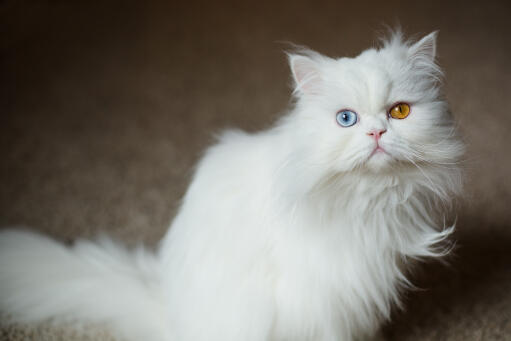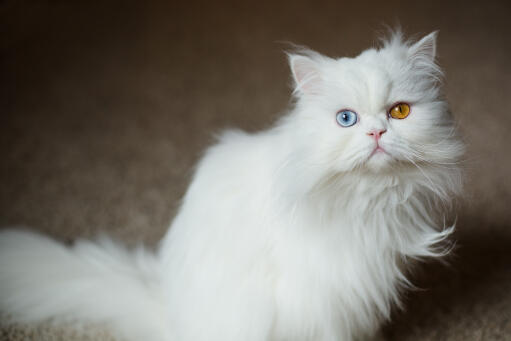Persian cats have always captivated people with their stunning beauty and charming personalities. But there is one particular trait that adds an air of mystery and intrigue to these already enigmatic felines: their odd-colored eyes. The mesmerizing combination of one blue eye and one eye of a different color has long fascinated cat lovers around the world. In this article, we will explore the fascinating world of Odd-Eyed Persian Cats, uncovering the secrets behind their captivating gaze and delving into the unique characteristics that make them truly one-of-a-kind. So, prepare to embark on a journey into the enigmatic and mysterious aura of these extraordinary creatures.
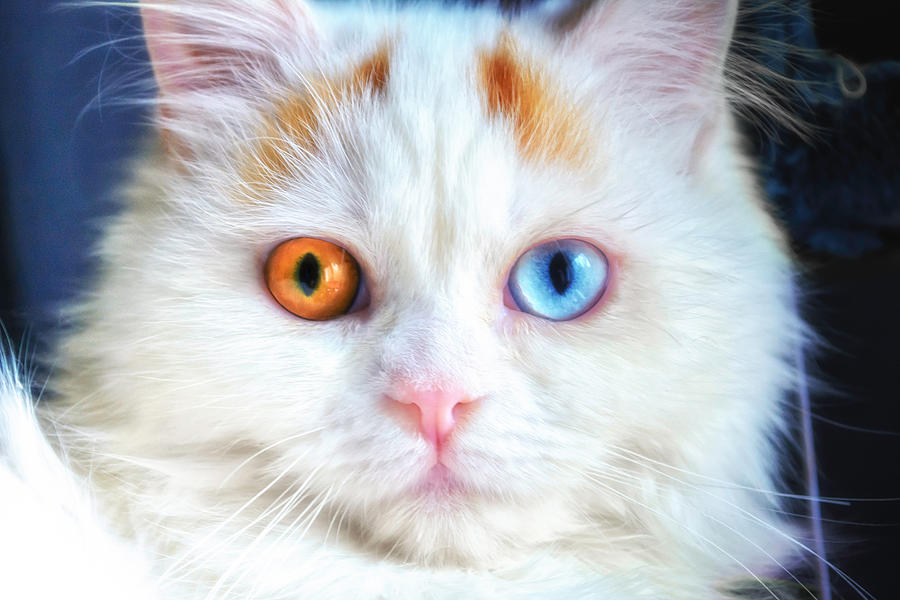
The Unique Appearance of Odd-Eyed Persian Cats
If you’ve ever come across an odd-eyed Persian cat, you would agree that they have an enigmatic and mysterious aura. With one eye of one color and the other of a different color, these felines stand out from the crowd. In this article, we will delve deeper into the world of odd-eyed Persians, exploring their physical features, historical significance, genetics, fascinating facts, and care requirements. So, let’s embark on this journey and unravel the secrets behind these captivating creatures.
Understanding the Odd-Eyed Trait
The odd-eyed trait in Persian cats is a result of a genetic mutation that affects the distribution of melanin, the pigment responsible for eye color. While most cats have eyes of the same color, odd-eyed Persians sport one eye with blue or green color and the other with gold or copper. This unique characteristic is a sight to behold and adds to their mystique.
Physical Features of Odd-Eyed Persian Cats
Apart from their distinctive eyes, odd-eyed Persian cats possess the trademark Persian features. They have a round face with a short, upturned nose, large round eyes, and a long, flowing coat. This breed is known for its stocky build and muscular structure. Their luxurious fur comes in various colors, making them even more visually striking.
Variations in Eye Color
The eye color of an odd-eyed Persian cat can vary greatly. The most common combination is one blue eye and one gold eye, but other combinations like green and copper or orange and yellow can also be seen. Some odd-eyed Persians may even have heterochromia, where different parts of the same eye show different colors. This diversity in eye color only adds to the allure of these captivating felines.
Comparison to Other Persian Cat Varieties
While odd-eyed Persians have their unique charm, it is essential to distinguish them from other Persian cat varieties. Traditional Persian cats, also known as doll-faced Persians, have round eyes of the same color. Exotic Shorthairs, on the other hand, are a Persian variant with a similar appearance but with short fur. Understanding these distinctions will help potential owners make an informed decision based on their preferences.
Historical Significance and Legends
Ancient Persian Beliefs and Superstitions
The odd-eyed trait of Persian cats has fascinated people for centuries, and legends and beliefs surrounding them have emerged. In ancient Persia, it was believed that odd-eyed cats possessed mystical powers and were blessed with good luck. It was also believed that they could ward off evil spirits and bring prosperity to their owners. These superstitions have given odd-eyed Persians a special place in Persian culture and folklore.
Symbolism and Cultural Associations
Odd-eyed Persian cats hold symbolic significance in different cultures. In Japan, they are considered a symbol of prosperity and good fortune, often featured in traditional artwork. In Turkish folklore, they are believed to bring blessings to households. The deep symbolism associated with these cats has contributed to their popularity and admiration worldwide.
Famous Odd-Eyed Persian Cats in History
Throughout history, there have been notable odd-eyed Persian cats that have left their mark. One such famous feline is Princess Vicky, the beloved pet of Queen Victoria. Known for her stunning appearance and regal demeanor, Princess Vicky captured the hearts of the royal family and became a symbol of elegance and grace. Stories of these famous odd-eyed Persians continue to inspire and fascinate cat lovers around the world.
The Genetics Behind Odd-Eyed Persians
Inheritance of the Odd-Eyed Trait
The odd-eyed trait in Persian cats is primarily determined by a genetic mutation. It is an autosomal dominant trait, which means that if a cat carries the odd-eyed gene, it will exhibit the trait. Odd-eyed Persians can produce both odd-eyed and non-odd-eyed kittens, depending on the genetic makeup of the parents. Understanding the inheritance patterns can assist breeders in selectively breeding for this unique trait.
Role of White Spotting Gene
The white spotting gene, known as the piebald gene, plays a significant role in the odd-eyed trait. Cats with this gene have a higher chance of being odd-eyed. The white spotting gene is responsible for the distribution of melanin, affecting the pigmentation of both the fur and the eyes. Breeding odd-eyed Persians requires careful consideration of the white spotting gene to maintain the desired eye color variation.
Genetic Testing and Breeding Considerations
Genetic testing is often recommended for breeders to determine the likelihood of producing odd-eyed Persians. This testing helps identify cats carrying the odd-eyed gene and helps breeders make informed decisions about breeding pairs. Responsible breeding practices and proper gene pool management are essential to maintain and preserve the unique traits associated with odd-eyed Persian cats.
Health Implications and Risks
While odd-eyed Persians are generally healthy cats, there are a few health conditions to be aware of. Some individuals may be prone to hearing impairments, especially when one blue eye is present. Regular veterinary check-ups are crucial to monitor their overall health and address any potential issues promptly. Maintaining a balanced diet, providing regular exercise, and grooming their lush coats are essential aspects of their care regimen.
Fascinating Facts about Odd-Eyed Persians
Rareness and Rarity Value
Odd-eyed Persians are considered rare due to the genetic anomaly that causes their distinct eye coloration. This rarity adds to their appeal and makes them highly sought after by cat enthusiasts and collectors. The unique and captivating appearance of these felines often leads to a higher demand and, consequently, a higher price tag.
Popularity among Cat Enthusiasts
Despite their rarity, odd-eyed Persians have gained popularity among cat enthusiasts worldwide. Their striking appearance and charming personality make them an ideal companion for those looking for a unique and loving pet. Their allure has captured the hearts of many, ensuring a devoted following of fans who appreciate their distinctive beauty.
Presence in Media and Pop Culture
Odd-eyed Persians have also made their mark in the world of media and pop culture. These felines have been featured in movies, television shows, and advertisements, captivating audiences with their mesmerizing eyes and regal presence. Their appearance in various forms of media further solidifies their reputation as fascinating and alluring creatures.
Unique Personality Traits
In addition to their captivating appearance, odd-eyed Persians possess unique personality traits that distinguish them from other cat breeds. They are known for their gentle and affectionate nature, often seeking human companionship. While they may be reserved with strangers, they form strong bonds with their owners and enjoy peaceful and calm environments. These cats thrive in a loving and nurturing home, making them a delightful addition to any family.
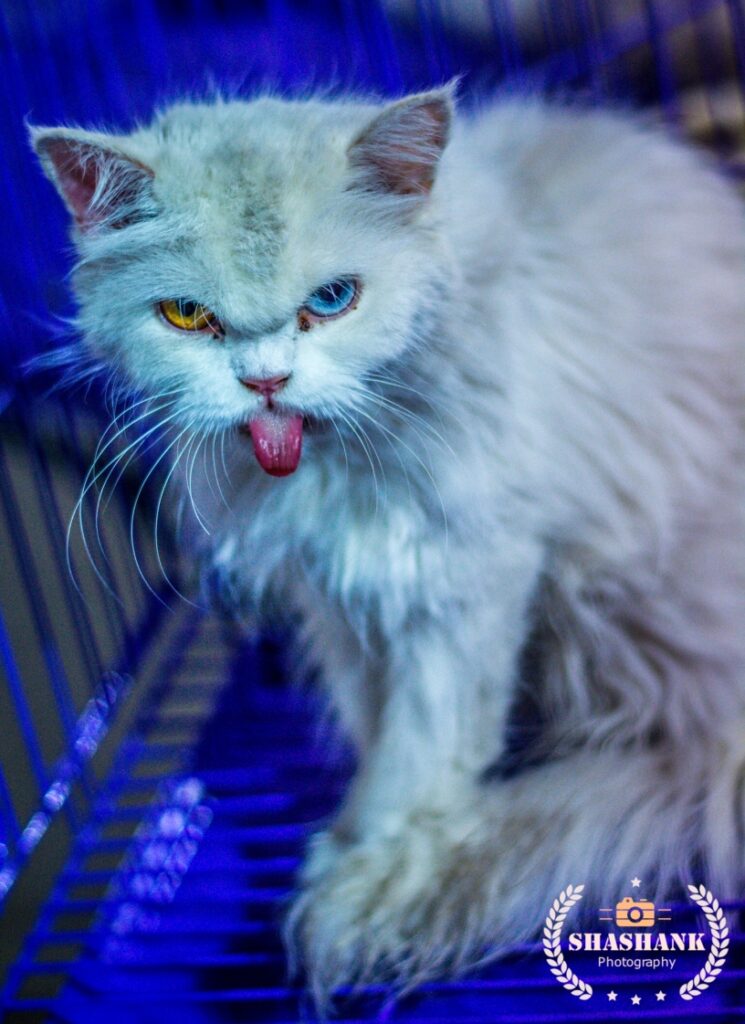
Caring for Odd-Eyed Persian Cats
Grooming and Coat Maintenance
Due to their long and luxurious coat, odd-eyed Persians require regular grooming to keep their fur in optimum condition. Daily brushing helps prevent matting and tangling, which can lead to discomfort and skin issues. Regular bathing, ear cleaning, and nail trimming are also essential aspects of their grooming routine. Ensuring a clean and well-groomed coat not only enhances their appearance but also promotes their overall health and well-being.
Eye Care and Health Monitoring
The unique eye coloration of odd-eyed Persians requires special attention to their eye care. Regular eye cleaning helps prevent any discharge or tear stains around the eyes. It is essential to monitor their eye health and seek veterinary attention if there are any signs of irritation or discomfort. Routine check-ups with a veterinarian will help ensure that their eyes are in good health and any potential issues are addressed promptly.
Nutritional Requirements
Maintaining a balanced and nutritious diet is crucial for the overall well-being of odd-eyed Persians. High-quality cat food that meets their specific dietary needs should be provided. Consultation with a veterinarian regarding the appropriate serving size and diet composition is recommended. Adequate hydration and access to fresh water at all times are essential to keep these felines healthy and hydrated.
Exercise and Playtime
While odd-eyed Persians are generally low-energy cats, regular exercise is still necessary to keep them physically and mentally stimulated. Engaging them in play sessions with interactive toys or providing scratching posts and climbing trees can help fulfill their instinctual needs. Ensuring a suitable environment for both rest and play is essential for their overall health and happiness.
Training and Socialization of Odd-Eyed Persians
Basic Obedience Training Techniques
Training odd-eyed Persians in basic obedience commands can help foster a harmonious relationship between you and your companion. Positive reinforcement techniques, such as rewards and treats, work best with these intelligent and eager-to-please cats. Consistency and patience are key when teaching commands such as sit, stay, and come. A well-trained and well-behaved odd-eyed Persian is a joy to have as a part of your family.
Introducing New Environments and People
Socializing your odd-eyed Persian at an early age is essential to ensure they are comfortable in various environments and with different people. Gradual exposure to new surroundings, sounds, and experiences will help them develop confidence and adaptability. This socialization process should be done with sensitivity and care, allowing them to adjust at their own pace.
Socializing with Other Pets
Introducing an odd-eyed Persian to other pets in the household requires careful supervision and gradual integration. Proper introductions, scent swapping, and supervised interactions can help foster positive relationships between your Persian and other furry companions. Cats are known for their individuality, so it’s essential to respect their preferences and personalities during the socialization process.
Understanding Behavioral Quirks
Odd-eyed Persians, like any other cat breed, have their unique behavioral quirks. Some may be more vocal, seeking attention through meowing, while others may prefer a quieter and more relaxed demeanor. Understanding and accommodating their individual personality traits will help create a harmonious living environment and strengthen the bond between you and your four-legged friend.
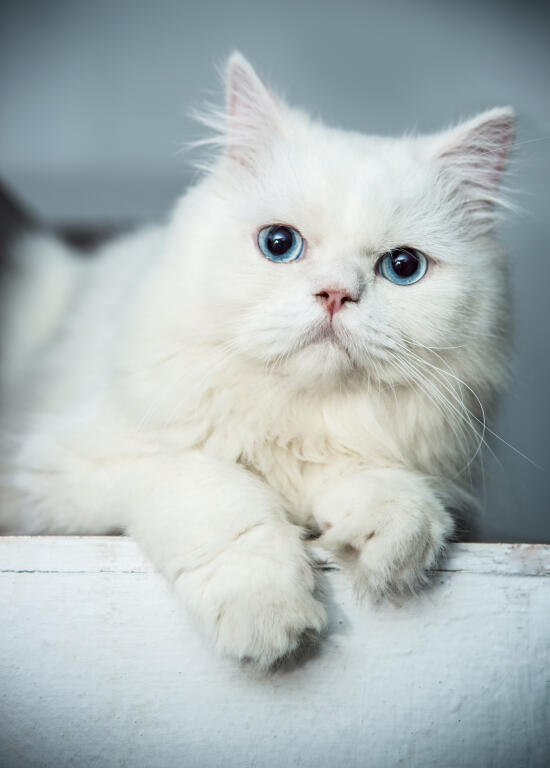
Introducing Odd-Eyed Persians into Your Home
Preparing Your Living Space
Before bringing an odd-eyed Persian into your home, it is important to prepare a safe and comfortable living space for them. Provide appropriate bedding, scratching posts, litter boxes, and places for them to hide and retreat when needed. Removing any hazards and ensuring a cat-friendly environment will help ease their transition and ensure their well-being.
Choosing the Right Odd-Eyed Persian
When selecting an odd-eyed Persian, consider factors such as temperament, health, and compatibility with your lifestyle. Research reputable breeders or adoption centers that prioritize the well-being and proper socialization of their cats. Take the time to interact with the kittens or cats in person and observe their behavior to ensure a good fit for your home.
Integrating with Existing Pets
When introducing an odd-eyed Persian to a household with existing pets, a gradual and supervised integration process is crucial. Allow the pets to familiarize themselves with each other’s scents before physically introducing them. Utilize positive reinforcement techniques and provide ample resources to avoid competition or conflict. With patience and proper introductions, your odd-eyed Persian can form harmonious relationships with existing pets.
Adapting to Family Lifestyle
Odd-eyed Persians thrive in a calm and quiet household, making them an ideal pet for families seeking a serene and peaceful environment. Their gentle nature makes them suitable companions for older children who can respect their boundaries and treat them with care and sensitivity. Consider your family’s lifestyle and the level of activity and noise when introducing an odd-eyed Persian into your home.
Common Health Issues and Care Tips
Genetic Predispositions to Certain Conditions
Like other cat breeds, odd-eyed Persians may have genetic predispositions to certain health conditions. Some common concerns in this breed include dental issues, respiratory problems, and polycystic kidney disease (PKD). Regular veterinary check-ups, proper dental care, and monitoring for any signs of distress or discomfort are essential in maintaining your cat’s health and well-being.
Routine Veterinary Check-ups
To ensure optimal health and early detection of any potential health issues, regular veterinary check-ups are crucial. Routine vaccinations, dental examinations, and blood tests can help identify any underlying health concerns. Your veterinarian will guide you in establishing a preventive healthcare plan tailored to your odd-eyed Persian’s specific needs.
Dental Care for Odd-Eyed Persians
Proper dental care is particularly important for odd-eyed Persians due to their brachycephalic (flat-faced) structure. Regular teeth brushing, offering dental treats, and incorporating dental hygiene practices into their routine can help prevent dental diseases such as periodontal issues and tooth decay. Good oral health contributes to their overall well-being and ensures a happy and healthy life.
Preventing Obesity and Promoting Exercise
As with any cat breed, odd-eyed Persians are prone to obesity. Maintaining a healthy weight is crucial for their overall health and longevity. Providing a balanced diet, measuring portion sizes, and engaging them in regular exercise are essential to prevent obesity. Interactive toys, puzzle feeders, and play sessions can help keep them mentally and physically stimulated.
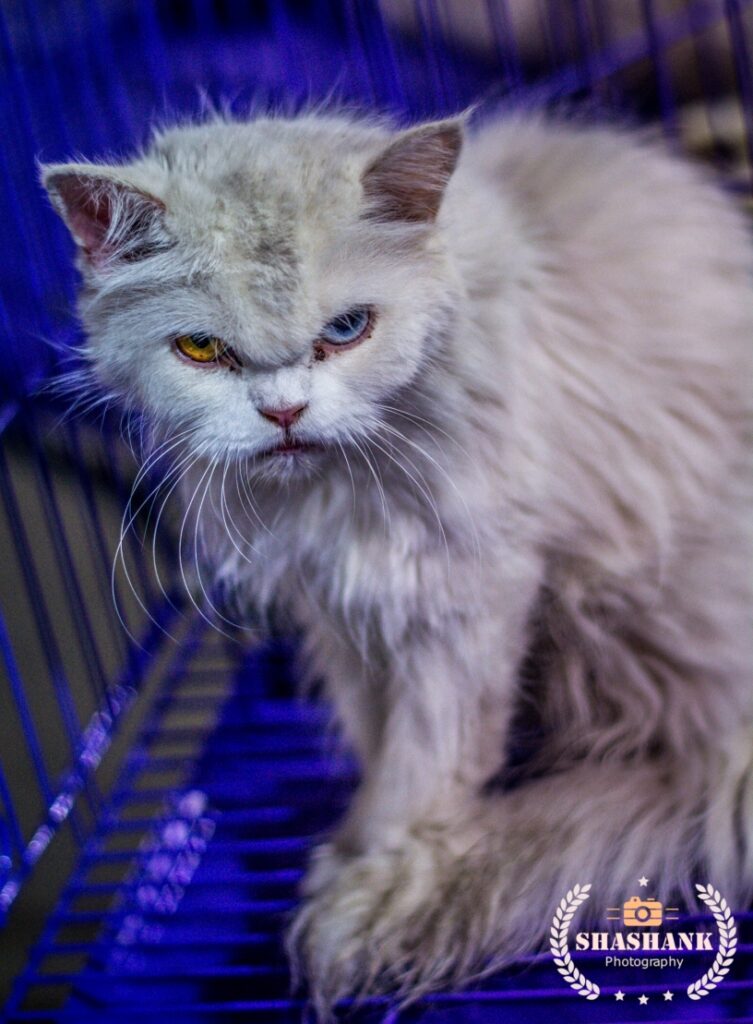
Odd-Eyed Persian Cats in Competitions and Shows
Breed Standards and Show Requirements
Odd-eyed Persians, like other cat breeds, are judged according to breed standards in competitions and shows. The standards outline specific physical attributes, coat colors, and eye color combinations that exemplify the breed’s ideal characteristics. Participating in shows with an odd-eyed Persian allows breeders and owners to showcase the unique beauty and distinctive traits of these felines.
Judging Criteria for Odd-Eyed Persians
In cat shows, odd-eyed Persians are judged based on several criteria, including eye color, coat condition, body structure, and temperament. Judges carefully examine and evaluate each cat, ensuring they meet the breed standards. Factors such as eye color balance, coat length and texture, and overall presentation contribute to the cat’s potential success in the show ring.
Famous Show-winning Odd-Eyed Persians
Throughout the history of cat shows, there have been several famous odd-eyed Persians that have left a lasting impact. From garnering prestigious titles to capturing the hearts of judges and spectators, these cats have become legends in the show world. Their success serves as a testament to the unique beauty and appeal of odd-eyed Persians in competitive arenas.
Finding and Adopting an Odd-Eyed Persian Companion
Reputable Breeders and Adoption Centers
If you are considering adding an odd-eyed Persian to your family, it is crucial to connect with reputable breeders or adoption centers. Conduct thorough research, read reviews, and visit their facilities to ensure they prioritize the well-being and ethical breeding practices of their cats. Responsible breeders and adoption centers will provide a suitable environment for the cats and offer guidance on their care and maintenance.
Considerations when Buying or Adopting
When choosing to buy or adopt an odd-eyed Persian, it is important to consider factors such as your lifestyle, budget, and ability to provide the necessary care and attention. Take the time to evaluate your readiness to commit to a lifelong companion. Ensure that you have the resources and knowledge to meet their needs and provide a loving and nurturing environment.
Rescue Organizations and Adoption Process
Rescue organizations also offer opportunities to adopt odd-eyed Persians in need of loving homes. These organizations assess and rehabilitate cats before placing them in suitable homes. The adoption process typically involves an application, interviews, and home visits to ensure the best match between the cat and the prospective family. Adopting a rescued odd-eyed Persian can be a rewarding experience, providing a second chance for both cat and owner.
Taking Care of Rescued Odd-Eyed Persians
Rescued odd-eyed Persians may require additional care and patience due to their past experiences. Providing a safe and nurturing environment, establishing a routine, and gradually introducing them to their new surroundings will help them adjust and feel secure. Tending to any physical and emotional needs, along with plenty of love and understanding, will ensure a smooth transition into their new forever home.
10 Common Questions and Answers about Persian Cats:
-
Q: Are Persian cats high maintenance in terms of grooming? A: Yes, Persian cats require regular grooming due to their long and luxurious coats. Daily brushing and occasional bathing are essential to keep their fur in good condition.
-
Q: Do Persian cats get along well with children and other pets? A: Persian cats are generally gentle and adaptable companions. With proper socialization, they can get along well with children and other pets in the household.
-
Q: Are all Persian cats flat-faced? A: While the flat-faced appearance is a defining characteristic of the Persian breed, there are variations within the breed that have a more traditional or doll-like face.
-
Q: Do Persian cats have any health issues that potential owners should be aware of? A: Persian cats are prone to certain health conditions, including respiratory problems, dental issues, and polycystic kidney disease. Regular veterinary check-ups can help monitor their health and address any concerns.
-
Q: How can I prevent matting in my Persian cat’s coat? A: Regular brushing of your Persian cat’s coat is crucial to prevent matting. Using a wide-toothed comb and detangling spray can help keep their fur free from knots and tangles.
-
Q: Do Persian cats require a specific diet? A: Persian cats should be fed a balanced and nutritious diet formulated for their specific needs. Consult with a veterinarian to determine the appropriate diet composition and serving size.
-
Q: Can Persian cats live in small living spaces, like apartments? A: Yes, Persian cats can adapt well to small living spaces as long as they have access to appropriate hiding spots, scratching posts, and stimulation through play and interaction.
-
Q: Are Persian cats prone to obesity? A: Persian cats have a tendency to gain weight, so it is important to monitor their food intake and provide regular exercise to prevent obesity. Consult with a veterinarian for dietary recommendations.
-
Q: How can I ensure my Persian cat’s eye health? A: Regular eye cleaning and monitoring for any signs of irritation or discharge are essential for maintaining your Persian cat’s eye health. Seeking veterinary attention if needed is important for early intervention.
-
Q: Are Persian cats suitable for first-time cat owners? A: Persian cats can be a good match for first-time cat owners, but it is important to be prepared for their grooming needs and commit to providing proper care and attention.
